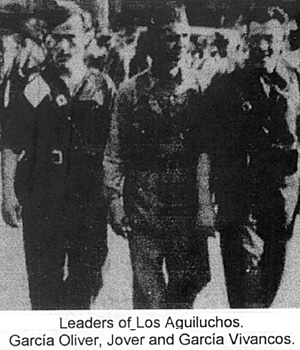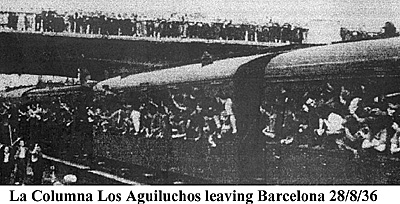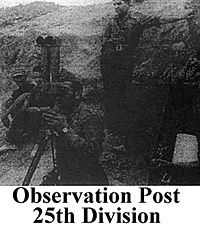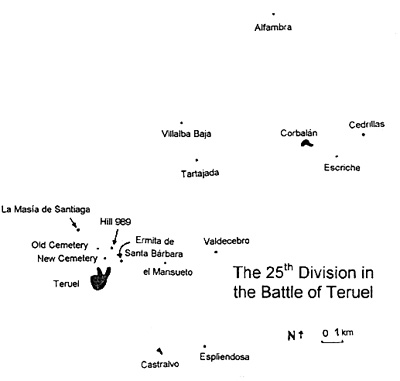 Miguel Garcia Vivancos was an active Anarchist before the Spanish Civil War, and had been a member of the Los Solidarios affinity group in the 1920s along with some of the most famous Spanish Anarchists including Buenaventura Durruti, Juan Garcia Oliver, Gregorio Jover and Francisco Ascaso. He left this group in 1930 and refused to rejoin it later in the 1930s when Garcia Oliver wanted to reform it as he didn't want to be a member of the same group as Durruti, who he felt was uncooperative and too impulsive. In early 1936 he was acting as a mediator in discussions between the Catalan Esquerra and the Nosotros Anarchist affinity group, and although the members of Nosotros trusted him he was not a member (possibly because Durruti was a member of this group).
Miguel Garcia Vivancos was an active Anarchist before the Spanish Civil War, and had been a member of the Los Solidarios affinity group in the 1920s along with some of the most famous Spanish Anarchists including Buenaventura Durruti, Juan Garcia Oliver, Gregorio Jover and Francisco Ascaso. He left this group in 1930 and refused to rejoin it later in the 1930s when Garcia Oliver wanted to reform it as he didn't want to be a member of the same group as Durruti, who he felt was uncooperative and too impulsive. In early 1936 he was acting as a mediator in discussions between the Catalan Esquerra and the Nosotros Anarchist affinity group, and although the members of Nosotros trusted him he was not a member (possibly because Durruti was a member of this group).
Garcia Vivancos was in Barcelona when the army rose against the government, and he was involved in suppressing their revolt there on the 19th July. He took part in the meetings on the 20th and 21st to plan the strategy for the advance into Aragon, and obtained transport for the 60 strong CNT detachment which left Barcelona later in the month to spur the Anarchists in Valencia into carrying out a decisive assault on those rebel troops who still held out in the city. As he had worked as a taxi driver, he spent much of the next few weeks acting as Garcia Oliver's chauffeur.
Recruiting
In mid August Garcia Oliver called on him and Gregorio Jover to assist in recruiting a force of between ten and fifteen thousand Anarchists to launch a decisive offensive to punch a hole in the Nationalist front line in Aragon. The Barcelona CNT daily, Solidaridad Obrera, carried an appeal in its 19th August issue calling for volunteers to join "La Columna Los Aguiluchos" which was being organised at the Bakunin barracks. Unfortunately for them, their plan hit a major obstacle as the CNT unions would only give permission to their members who were aged between 16 and 18 to join this column, as they were afraid that the departure of a larger number of their members from Barcelona would both deprive the war industry of manpower and leave the Barcelona CNT bereft of active members.
Both Garcia Oliver and Garcia Vivancos were disgusted by the unions' decision, and the latter suggested that although the unions' refusal to release their members would prevent them from organising the decisive force that they had planned to , they should organise the column as it could be incorporated into the Anarchist unit already serving at the front .Thus recruitment went ahead and on the 28th August the column left for the front. It marched out of the Bakunin barracks and filed down the Via Layetana with red and black flags flying, past the Casa CNT-FAI, and was given an official send off by General Aranguren, the head of the Civil Guard, who presented Garcia Oliver with four submachine guns. The propaganda department of the Catalan Anti-Fascist Militias Committee were also present, as was Juan Pens, the committee's Esquera delegate
The column was 1500 strong (over 200 of whom were female), and had Captain Jose Guarner as it's military advisor (to whom Vicente Aranda dedicated his film "Libertarias"). The column was armed with rifles and a number of machine guns, and had some armoured vehicles in support (further armoured vehicles arrived soon after it reached the front, including one made specially for Garcia Oliver by the Hispano-Suiza factory).Considering that recruitment was only announced on the 19'" and the column left Barcelona on the 28th, there was not much time for its members to be trained nor to accustom themselves to the discomforts of military life, as was soon to become apparent.
 The Column left Barcelona by train and travelled to Granen by Train in Huesca province where they spent the night in a wood. They were advised by the locals to shelter there as it was a good place to sleep and would provide cover in the morning from air observation , though the column's leaders found shelter in the town itself.
The Column left Barcelona by train and travelled to Granen by Train in Huesca province where they spent the night in a wood. They were advised by the locals to shelter there as it was a good place to sleep and would provide cover in the morning from air observation , though the column's leaders found shelter in the town itself.
Mutiny
In his autobiography Garcia Oliver related how he was just preparing to settle down to eat when Garcia Vivancos burst in on him to announce that they had a mutiny on their hands. It had not been possible to cook a warm meal and therefore a cold ration had been distributed. Many members of the column complained at this, for as fighters for the social revolution they believed that they deserved better. Garcia Oliver decided that it was better not to over react to their complaints, and after having eaten his own cold rations he set off for the woods with a number of armed companions. There he spoke to the assembled militiamen and women and gave them the chance to shoot him in the back.
Despite much muttering they declined to take advantage of this opportunity and eventually settled down. Although this outburst was easily dealt with, it showed that the column still had a long way to go before it would become an efficient military unit.
From Graiien the column proceeded to Vicien which was the nearest Anarchist held position before Huesca. Here they were welcomed by Domingo Ascaso and Cristobal Aldabaldetreco from the Red and Black column. This column covered Barbastro, Graiien and Vicien, and' Los Aguiluchos' took up position alongside them. The warm welcome and the assistance which they received from the more experienced members of the red and black column helped to accustom los aguiluchos to the discomforts of war. The column then made Castilio de Vicien into their base. This was a large farm with some sizeable air raid shelters nearby which had been built by Valero , a CNT construction worker.
After they had settled in a conference took place where Ascaso and Aldabaldetreco reported that things were not going well in their part of the front because the columns didn't co-operate effectively. Although the militias would not retire, they were just as unwilling to launch any large scale offensives, hence they had all dug in. At this meeting it was decided to split the column in two, with Garcia Vivancos in command of the first part which was to act as an advance guard. They were given some vehicles by Damians (aka Pancho Villa), including a number of motorised canteens.
Front Line
The front line was being strafed on occasion by Nationalist aircraft who would attack whenever they saw any signs of movement. To prevent this sentries were posted to watch for enemy aircraft, and if any were seen alarm bells were set off so that everyone would have time to take cover. Los Aguiluchos were in close proximity to the Italian Malatesta Battalion, and one evening when Garcia Oliver had been invited to a meal by Carlo Rosselli, the battalion's leader, the unit's reserves and transport which were situated in a wood were bombed and strafed by Nationalist fighters. The drivers and their assistants suffered many losses and Garcia Oliver described the woods as a scene of carnage with many dead hanging out of the cabs of their lorries. It was later discovered that a Nationalist sympathiser was placing glass bottles which glinted in the sunlight on suitable targets,and a number were found in the branches of the trees in the wood which was attacked.
A meeting of all column leaders on the Huesca front was called by Colonel Villalba where it was decided to launch an offensive at 05.00 the next morning along the entire front. This operation was a total failure as the largest assault didn't start until 07.00, with all the other attacks being underway by 08.00. However, by then Captain Medrano who was giving artillery support to the attack had run out of shells.
Garcia Oliver was called back to Barcelona by Mariano Vazquez, the national secretary of the CNT, and he left in low spirits as he felt that his original plan to bring a large and fresh unit into the line to achieve a decisive breakthrough had failed. He left Gregorio Jover in command of the column with Garcia Vivancos as second in command.
It was in September 1936 that Garcia Vivancos began a campaign in favour of militarisation, and in this he received the support of the majority of the battalion which he commanded. He did however have to expel one member from a "puritan" group who consistently resisted his authority. Many arguments took place among the column, with both Garcia Vivancos and Jover pressing for militarisation. The leading opponent of militarisation on the Huesca front was Domingo Ascaso, whose column was not militarised until February 1937. With the merging of Los Aguiluchos into the Popular Army he was placed in command of the 125th mixed brigade, which was formed from the former Ascaso, Los Aguiluchos and Red and Black columns. His main problems at this time were with those strong willed anarchists who continued to resist the militarisation process, especially in the Malatesta Battalion.
He was successful in persuading the POUM's 29th division not to leave the front for Barcelona during the May Days, as well as those of his own troops who wanted to go there to fight the Communists. Along with Ricardo Sanz and Gregorio Jover, the commanders of the 26th and 28th divisions, he contributed enormously to the maintenance of the Aragon front while the fighting raged in Barcelona. During the summer he influenced the 29th division to expel some of its members who were still resisting the militarisation process, though he did oppose the order to dissolve the POUM.
 In the summer of 1937 his unit fought at the battles of Belchite and Fuentes de Ebro, where he found Antonio Ortiz to be uncooperative. When General Pozas, the head of the Army of the East decided to remove Ortiz from command of the 25th division, he posted Garcia Vivancos in his place. In line with common practice at the time, Pozas' appointment of Garcia Vivancos had to be referred to the national committee of the CNT, which agreed with his recommendation and allowed Ortiz to be replace December 1937 saw the 25th division in position for the
Republican's attack on Teruel as part of the XXII Army Corps which was commanded by Ibarrola, a devout Catholic and Civil Guard officer who had fought in the campaign in the north and had a good relationship with the Communists. The other unit in the corps was Enrique Lister's 11th Communist division. By this time the 25 th division was considered a veteran and experienced unit, and the days of democratic decision making were gone.
In the summer of 1937 his unit fought at the battles of Belchite and Fuentes de Ebro, where he found Antonio Ortiz to be uncooperative. When General Pozas, the head of the Army of the East decided to remove Ortiz from command of the 25th division, he posted Garcia Vivancos in his place. In line with common practice at the time, Pozas' appointment of Garcia Vivancos had to be referred to the national committee of the CNT, which agreed with his recommendation and allowed Ortiz to be replace December 1937 saw the 25th division in position for the
Republican's attack on Teruel as part of the XXII Army Corps which was commanded by Ibarrola, a devout Catholic and Civil Guard officer who had fought in the campaign in the north and had a good relationship with the Communists. The other unit in the corps was Enrique Lister's 11th Communist division. By this time the 25 th division was considered a veteran and experienced unit, and the days of democratic decision making were gone.
Offensive
This time only the top leaders knew the plan of campaign, and the division assembled for the offensive at Corbalsn, Escriche and Cedrillas. The attack was launched at first light on the 15th when the 116th and 117th brigades left Tartajada to assault the Nationalist positions facing them. Although they encountered strong resistance, they were in possession of the first line of Nationalist defences by the evening.
They spent the 16th December consolidating their flanks, though they were hampered in their efforts by the wind and heavy snow. The unit was unprepared for the cold weather, and as they were on the move the troops found it hard to find shelter from the ravages of the climate. On the 17th they attacked Teruel cemetery with the support of 20 Russian T-26 tanks, though they only managed to take two enemy positions. The next day unsuccessful attacks were launched on both the Teruel cemetery as before and the Ermita de Santa Barbara, with both these Nationalist positions now coming under constant fire and intermittent attacks.
The 19th saw the division advancing between LaMasia de Santiaga and the old Teruel cemetery. Despite failing in their attempt to occupy the latter position, their leading troops were now only one kilometre from the outskirts of Teruel. In the evening one brigade was withdrawn to the rear to rest, and the artillery was reorganised in preparation for the main attack on the town, though this was postponed until the 21st due to the continuing bad weather.
The combat on the 21st lasted all day and into the night as the Anarchists attempted to seize the Nationalist positions on the outskirts of the town, including the Ermita and Cerro de Santa Barbara, El Mansueto and the new and old cemeteries, though only the latter was captured. The next day their attack was temporarily halted as the XXII Corps was ordered to defend against Nationalist counterattacks from the north. At the same time the 40th Carabineers division led by the Anarchist Major Nieto was advancing north through Teruel itself, though it was unable to link up with the 25th division due to the continued Nationalist control of the new cemetery and El Mansueto.
The XXII Corps spent the 23rd mopping up Nationalist positions in their rear, and it achieved some remarkable successes in the morning, for the Ermita de Santa Barbara fell at 05:55, the new cemetery at 06:05, hill 989 at 07:55, and El Mansueto at 10:10. These successes enabled them to link up with the 40th division, though this led to some conflict between them over captured booty.
Garcia Vivancos' division was split on the 28th December as the 116th brigade reinforced the 39th division and the 117th and 118th brigades reinforced Lister's 11th division to hold against Nationalist counter attacks. On the 30th the division fought as a single unit again as it took up positions in the old cemetery, the Ermita de Santa Barbara, El Mansueto, and the ridges near Espliendosa and north and west of Castralvo which guarded the road to Cuenca.
Hold at All Costs
Garcia Vivancos received the order from Ibarrola to hold these positions at all costs.
On the 31st the division held the line between Villaespesa and the old cemetery in conjunction with the 40th division, while the 11th division was reorganised in the area of Alfambra and Villalba Baja. The temperatures had by this time fallen to 18-20 degrees below zero and the freezing conditions were taking their toll on the men's health. On the 31st December there were 58 foot and hand amputations carried out in Lister's division alone. It was on this day that Lister refused to send a brigade into the front line even though he was ordered to do so by Ibarrola.
On the 2nd January the Nationalist 61st division launched an attack and succeeded in pushing back one brigade from the 25th division and another brigade from the 68th division, both of which retired in disorder. A battalion of Assault Guards was brought into the line and it managed to stem the Nationalist advance. On the 6th Garcia Vivancos' men were defending the old cemetery against fierce Nationalist attacks, though both they and Lister's troops were pulled out from the front line when the Nationalists recaptured Teruel. Although the battle of Teruel was a failure for Republican forces, the responsibility for the failure of the 25th division to defend it's gains was not Garcia Vivancos' alone, for he had been given an impossible task.
The 25th division remained as part of the XXII Corps, and the other units in the Corps were now the 28th and 66th Anarchist divisions. When the division was ordered to re-enter the line at Valdecebro in response to a Nationalist offensive which began on the 17th, Saturnine Cared, the division's political commissar, refused to countersign the order as the division lacked arms and equipment. Garcia Vivancos exploded at this and thumping the table he shouted that "if there are no arms we'll fight with sticks and stones, with our nails. This order has got to be obeyed." While they were arguing the order came through to report to headquarters. Cared relented and went to headquarters. He was told that he would only receive enough arms to re-equip the division if he agreed to join the Communist party. As he refused he received no arms, and unfortunately for the 25th division the one supply dump where they could have obtained some arms, was captured by the Nationalists before they could reach it.
When the 117th brigade returned to the front without having had time to rest or reorganise it was destroyed in a Nationalist air attack. The brigade was reformed with 600 new recruits, though it had taken such a beating that even then it was only 1831 strong. These new recruits only knew how to march in close order and they had not even learnt how to fire a rifle or throw a hand grenade. There weren't enough rifles to go round and many of the rifles which they did have were in bad condition.
Withdrawals
The 25th division suffered severely in the withdrawals of March 1938 and was sent to the quieter centre-south region to recover, where they became part of the XVII Corps. Garcia Vivancos was then removed from command and replaced by Eusebio Sanz. During his military career Garcia Vivancos was a major driving force to militarise the militias, and he also helped to maintain discipline along the Aragon front during the May Days. General Lister described him and the other Anarchists who he fought alongside as "magnificent and disciplined". He was highly commended by General Pozas, who praised his conduct at the battles of Belchite and Fuentes de Ebro. Possibly the strongest sentiments came from Emma Goldman who met him during her trips to Republican Spain. She described him as "a born leader" who was "greatly beloved by his men". Perhaps her acclamations went too far when she described him as the hero of Belchite and the man who captured Teruel, though without doubt he made a large contribution to the Republican war effort at both of these battles.
Map

Back to Abanderado Vol. 3 No. 3 Table of Contents
Back to Abanderado List of Issues
Back to MagWeb Master Magazine List
© Copyright 1997 by Rolfe Hedges
This article appears in MagWeb (Magazine Web) on the Internet World Wide Web. Other military history articles and gaming articles are available at http://www.magweb.com